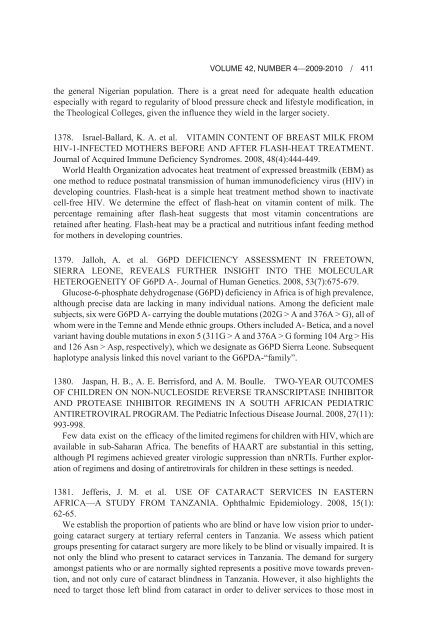A Current Bibliography on African Affairs - Baywood Publishing
A Current Bibliography on African Affairs - Baywood Publishing
A Current Bibliography on African Affairs - Baywood Publishing
Create successful ePaper yourself
Turn your PDF publications into a flip-book with our unique Google optimized e-Paper software.
VOLUME 42, NUMBER 4—2009-2010 / 411<br />
the general Nigerian populati<strong>on</strong>. There is a great need for adequate health educati<strong>on</strong><br />
especially with regard to regularity of blood pressure check and lifestyle modificati<strong>on</strong>, in<br />
the Theological Colleges, given the influence they wield in the larger society.<br />
1378. Israel-Ballard, K. A. et al. VITAMIN CONTENT OF BREAST MILK FROM<br />
HIV-1-INFECTED MOTHERS BEFORE AND AFTER FLASH-HEAT TREATMENT.<br />
Journal of Acquired Immune Deficiency Syndromes. 2008, 48(4):444-449.<br />
World Health Organizati<strong>on</strong> advocates heat treatment of expressed breastmilk (EBM) as<br />
<strong>on</strong>e method to reduce postnatal transmissi<strong>on</strong> of human immunodeficiency virus (HIV) in<br />
developing countries. Flash-heat is a simple heat treatment method shown to inactivate<br />
cell-free HIV. We determine the effect of flash-heat <strong>on</strong> vitamin c<strong>on</strong>tent of milk. The<br />
percentage remaining after flash-heat suggests that most vitamin c<strong>on</strong>centrati<strong>on</strong>s are<br />
retained after heating. Flash-heat may be a practical and nutritious infant feeding method<br />
for mothers in developing countries.<br />
1379. Jalloh, A. et al. G6PD DEFICIENCY ASSESSMENT IN FREETOWN,<br />
SIERRA LEONE, REVEALS FURTHER INSIGHT INTO THE MOLECULAR<br />
HETEROGENEITY OF G6PD A-. Journal of Human Genetics. 2008, 53(7):675-679.<br />
Glucose-6-phosphate dehydrogenase (G6PD) deficiency in Africa is of high prevalence,<br />
although precise data are lacking in many individual nati<strong>on</strong>s. Am<strong>on</strong>g the deficient male<br />
subjects, six were G6PD A- carrying the double mutati<strong>on</strong>s (202G > A and 376A > G), all of<br />
whom were in the Temne and Mende ethnic groups. Others included A- Betica, and a novel<br />
variant having double mutati<strong>on</strong>s in ex<strong>on</strong> 5 (311G > A and 376A > G forming 104 Arg > His<br />
and 126 Asn > Asp, respectively), which we designate as G6PD Sierra Le<strong>on</strong>e. Subsequent<br />
haplotype analysis linked this novel variant to the G6PDA-“family”.<br />
1380. Jaspan, H. B., A. E. Berrisford, and A. M. Boulle. TWO-YEAR OUTCOMES<br />
OF CHILDREN ON NON-NUCLEOSIDE REVERSE TRANSCRIPTASE INHIBITOR<br />
AND PROTEASE INHIBITOR REGIMENS IN A SOUTH AFRICAN PEDIATRIC<br />
ANTIRETROVIRAL PROGRAM. The Pediatric Infectious Disease Journal. 2008, 27(11):<br />
993-998.<br />
Few data exist <strong>on</strong> the efficacy of the limited regimens for children with HIV, which are<br />
available in sub-Saharan Africa. The benefits of HAART are substantial in this setting,<br />
although PI regimens achieved greater virologic suppressi<strong>on</strong> than nNRTIs. Further explorati<strong>on</strong><br />
of regimens and dosing of antiretrovirals for children in these settings is needed.<br />
1381. Jefferis, J. M. et al. USE OF CATARACT SERVICES IN EASTERN<br />
AFRICA—A STUDY FROM TANZANIA. Ophthalmic Epidemiology. 2008, 15(1):<br />
62-65.<br />
We establish the proporti<strong>on</strong> of patients who are blind or have low visi<strong>on</strong> prior to undergoing<br />
cataract surgery at tertiary referral centers in Tanzania. We assess which patient<br />
groups presenting for cataract surgery are more likely to be blind or visually impaired. It is<br />
not <strong>on</strong>ly the blind who present to cataract services in Tanzania. The demand for surgery<br />
am<strong>on</strong>gst patients who or are normally sighted represents a positive move towards preventi<strong>on</strong>,<br />
and not <strong>on</strong>ly cure of cataract blindness in Tanzania. However, it also highlights the<br />
need to target those left blind from cataract in order to deliver services to those most in




